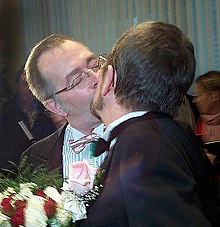Chemical basis
Biological models of sex tend to view love as a mammalian drive, much like hunger or thirst. Helen Fisher, a leading expert in the topic of love, divides the experience of love into three partly overlapping stages: lust, attraction, and attachment. Lust exposes people to others; romantic attraction encourages people to focus their energy on mating; and attachment involves tolerating the spouse (or indeed the child) long enough to rear a child into infancy.
Lust is the initial passionate sexual desire that promotes mating, and involves the increased release of chemicals such as testosterone and estrogen. These effects rarely last more than a few weeks or months. Attraction is the more individualized and romantic desire for a specific candidate for mating, which develops out of lust as commitment to an individual mate forms. Recent studies in neuroscience have indicated that as people fall in love, the brain consistently releases a certain set of chemicals, including pheromones, dopamine, norepinephrine, and serotonin, which act in a manner similar to amphetamines, stimulating the brain's pleasure center and leading to side effects such as increased heart rate, loss of appetite and sleep, and an intense feeling of excitement. Research has indicated that this stage generally lasts from one and a half to three years.
Since the lust and attraction stages are both considered temporary, a third stage is needed to account for long-term relationships. Attachment is thebonding that promotes relationships lasting for many years and even decades. Attachment is generally based on commitments such as marriage andchildren, or on mutual friendship based on things like shared interests. It has been linked to higher levels of the chemicals oxytocin and vasopressin to a greater degree than short-term relationships have. Enzo Emanuele and coworkers reported the protein molecule known as the nerve growth factor(NGF) has high levels when people first fall in love, but these return to previous levels after one year.
Psychological basis
Further information: Human bonding
Psychology depicts love as a cognitive and social phenomenon. Psychologist Robert Sternberg formulated atriangular theory of love and argued that love has three different components: intimacy, commitment, and passion. Intimacy is a form in which two people share confidences and various details of their personal lives, and is usually shown in friendships and romantic love affairs. Commitment, on the other hand, is the expectation that the relationship is permanent. The last and most common form of love is sexual attraction and passion. Passionate love is shown in infatuation as well as romantic love. All forms of love are viewed as varying combinations of these three components. American psychologist Zick Rubinsought to define love by psychometrics in the 1970s. His work states that three factors constitute love: attachment, caring, and intimacy.
Following developments in electrical theories such as Coulomb's law, which showed that positive and negative charges attract, analogs in human life were developed, such as "opposites attract." Over the last century, research on the nature of human mating has generally found this not to be true when it comes to character and personality—people tend to like people similar to themselves. However, in a few unusual and specific domains, such as immune systems, it seems that humans prefer others who are unlike themselves (e.g., with an orthogonal immune system), since this will lead to a baby that has the best of both worlds. In recent years, various human bonding theories have been developed, described in terms of attachments, ties, bonds, and affinities.
Some Western authorities disaggregate into two main components, the altruistic and the narcissistic. This view is represented in the works of Scott Peck, whose work in the field of applied psychology explored the definitions of love and evil. Peck maintains that love is a combination of the "concern for the spiritual growth of another," and simple narcissism. In combination, love is an activity, not simply a feeling.
Noted psychologist Eric Fromm also maintained in his book "The art of loving" that love is not merely a feeling but is also actions, and that in fact, the "feeling" of love is superficial in comparison to ones commitment to love via a series of loving actions over time. In this sense, Fromm held that love is ultimately not a feeling at all, but rather is a commitment to, and adherence to, loving actions towards another, ones self, or many others, over a sustained duration. Fromm also described Love as a conscious choice that in its early stages might originate as an involuntary feeling, but which then later no longer depends on those feelings, but rather depends only on conscious commitment.
Comparison of scientific models
Biological models of love tend to see it as a mammalian drive, similar to hunger or thirst. Psychology sees love as more of a social and cultural phenomenon. There are probably elements of truth in both views. Certainly love is influenced by hormones (such as oxytocin), neurotrophins (such as NGF), and pheromones, and how people think and behave in love is influenced by their conceptions of love. The conventional view in biology is that there are two major drives in love: sexual attraction and attachment. Attachment between adults is presumed to work on the same principles that lead an infant to become attached to its mother. The traditional psychological view sees love as being a combination of companionate love and passionate love. Passionate love is intense longing, and is often accompanied by physiological arousal (shortness of breath, rapid heart rate); companionate love is affection and a feeling of intimacy not accompanied by physiological arousal.
(source :



Walang komento:
Mag-post ng isang Komento